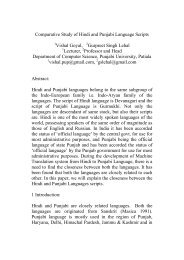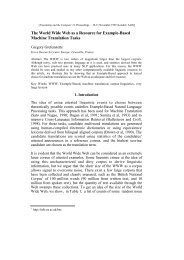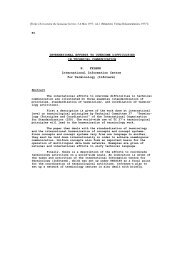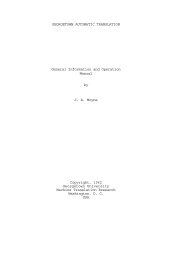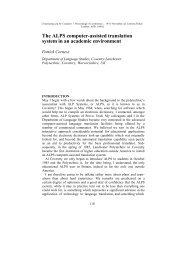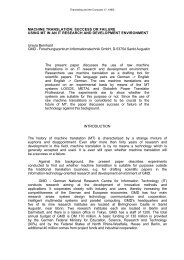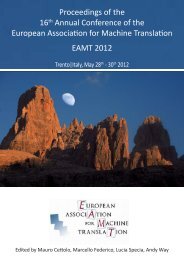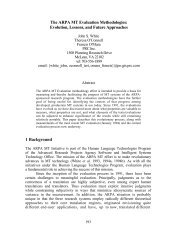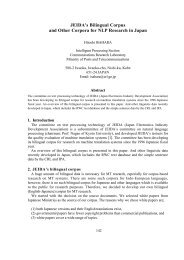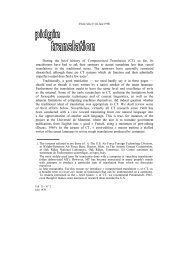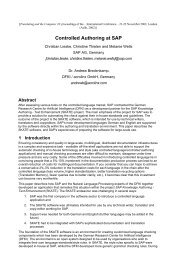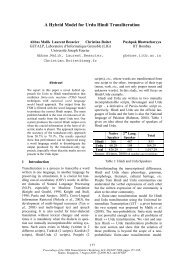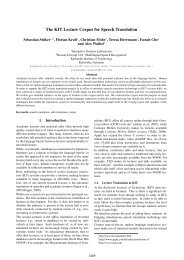Machine translation with inferred finite-state transducers
Machine translation with inferred finite-state transducers
Machine translation with inferred finite-state transducers
Create successful ePaper yourself
Turn your PDF publications into a flip-book with our unique Google optimized e-Paper software.
Computational Linguistics Volume 30, Number 2<br />
Figure 2<br />
Basic scheme for the inference of <strong>finite</strong>-<strong>state</strong> <strong>transducers</strong>. A is a <strong>finite</strong> sample of training pairs.<br />
S is the <strong>finite</strong> sample of strings obtained from A using L. G is a grammar <strong>inferred</strong> from S such<br />
that S is a subset of the language, L(G), generated by the grammar G. T is a <strong>finite</strong>-<strong>state</strong><br />
transducer whose <strong>translation</strong> (T(T )) includes the training sample A.<br />
point in this approach is its first step, that is, how to conveniently transform a parallel<br />
corpus into a string corpus. In general, there are many possible transformations, but<br />
if the source–target correspondences are complex, the design of an adequate transformation<br />
can become difficult. As a general rule, the labeling process must capture these<br />
source–target word correspondences and must allow for a simple implementation of<br />
the inverse labeling needed in the third step.<br />
A very preliminary, nonstochastic version of this <strong>finite</strong>-<strong>state</strong> transducer inference<br />
technique was presented in Vidal, García, and Segarra (1989) An important drawback<br />
of that early proposal was that the methods proposed for building the Γ ⋆ sentences<br />
from the training pairs did not adequately cope <strong>with</strong> the dependencies between the<br />
words of the source sentences and the words of the corresponding target sentences. In<br />
the following section we show how this drawback can be overcome using statistical<br />
alignments (Brown et al. 1993).<br />
The resulting methodology is called grammatical inference and alignments for<br />
transducer inference (GIATI). 5 A related approach was proposed in Bangalore and<br />
Ricardi (2000b). In that case, the extended symbols were also built according to previously<br />
computed alignments, but the order of target words was not preserved. As a<br />
consequence, that approach requires a postprocess to try to restore the target words<br />
to a proper order.<br />
4.1 Statistical Alignments<br />
The statistical <strong>translation</strong> models introduced by Brown et al. (1993) are based on the<br />
concept of alignment between source and target words (statistical alignment models).<br />
Formally, an alignment of a <strong>translation</strong> pair (s, t) ∈ Σ ⋆ × ∆ ⋆ is a function<br />
a : {1, ..., |t|} → {0, ..., | s |}. The particular case a(j) =0 means that the position j<br />
in t is not aligned <strong>with</strong> any position in s. All the possible alignments between t and<br />
s are denoted by A(s, t), and the probability of translating a given s into t by an<br />
alignment a is Pr(t, a | s).<br />
Thus, an optimal alignment between s and t can be computed as<br />
210<br />
â = argmax Pr(t, a | s) (11)<br />
a∈A(s,t)<br />
5 In previous work, this idea was often called morphic generator transducer inference.



